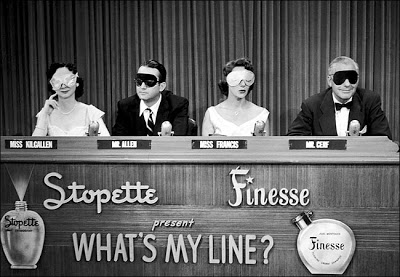When the Interactive Advertising Bureau Internet Advertising Revenue Report came in for the second quarter of 2008, I took one quick look at the figures compiled by the PriceWaterhouseCoopers accounting firm and immediately said (first to myself, and then to anyone who cared to listen), “It’s a normal recession trend: Above-the-line dollars are moving below-the-line.”
 I was surprised to discover how few people trained in interactive advertising had any idea what I was talking about.
I was surprised to discover how few people trained in interactive advertising had any idea what I was talking about.
I will explain, because it’s a response to the increasingly prevalent and nonsensical fear that the online display ad market is collapsing. It’s not — in fact, it’s growing. But to understand how and where and why, let me provide a short course on marketing practice.
The Purchase Funnel
Marketing needs are typically defined by an image called “the purchase funnel,” a diagram of consumer decision-making identified with the automotive research firm Allison-Fisher International. In this inverted triangle, consumption choices begin with awareness, and gradually narrow to consumer familiarity, consideration, preference, purchase, and ultimately loyalty.
Different marketing disciplines long have been associated with different levels of this funnel. Awareness is generated by main-media advertising — typically big blasts on television, billboards, and in magazines. Consideration might have more of a retail angle — newspaper or radio advertising, say, announcing a product’s availability for a limited period at a local store or dealership. Purchase often is motivated by a favorable price — a consumer promotion featured in a newspaper’s free-standing insert or in a direct-mailed catalogue — or merely the fact that the product shows up, thanks to a trade-promotion deal between a manufacturer and a retailer, on an end-aisle display in a grocery store. Loyalty depends on the user experience, naturally, but consumer-relationship marketing (frequent flier and after-market service programs, for example) can play a significant role.
The upper part of the funnel, the functions associated with measured media advertising aimed at fostering brand or product awareness and consideration, are typically referred to as “above the line,” while the tasks that relate more directly to selling are termed “below the line.” Wikipedia attributes the terminology to Procter & Gamble’s methods for accounting for its marketing expenditures beginning in the 1950s, but the phrasing almost certainly derives from the way business expenses — notably, deductions from adjusted gross income — are conventionally dealt with in accounting.
Moving the Metal
It’s an axiom of marketing that when the economy gets rough, marketers shift budgets from above the line programs to below the line — that is, they trade off the longer-term effects of brand-building for the shorter-term need to move products off shelves. While such swapping pains publishers, ad agencies, and marketers’ own advertising teams, the economics of a business often demand it.
 Consider the U.S. automotive industry, now in as tortured a position as it’s ever been. Automakers don’t sell cars to consumers: They sell cars to dealers, who in turn sell them to consumers. Dealers, just like consumers, have to finance those purchases; unlike consumers, though, they have to finance them in volume, a system known in the auto business as “floor planning.” When consumers stop purchasing cars, dealers can quickly get upside-down on their own loans. They often have little choice but to demand help from Detroit, in the form of incentives and rebates and other “trading money,” to move the metal now.
Consider the U.S. automotive industry, now in as tortured a position as it’s ever been. Automakers don’t sell cars to consumers: They sell cars to dealers, who in turn sell them to consumers. Dealers, just like consumers, have to finance those purchases; unlike consumers, though, they have to finance them in volume, a system known in the auto business as “floor planning.” When consumers stop purchasing cars, dealers can quickly get upside-down on their own loans. They often have little choice but to demand help from Detroit, in the form of incentives and rebates and other “trading money,” to move the metal now.
I can’t do any better in explaining the dealers’ dilemma than the description I offered in my last book, Where the Suckers Moon: The Life and Death of an Advertising Campaign. Here’s what auto retailers faced during the recession of 1991:
Under the floor-planning system, every day a car sat at a dealership, it cost them money — the interest they paid on the loans they took to buy the cars at wholesale. A car with a wholesale cost of $13,000 financed at two points above the late 1991 prime of 6.5 percent cost the dealer $1,105 a year, or slightly more than $3 a day. As a rule of thumb, dealers liked to keep a two months’ supply of cars on the lot, and ordered them from the manufacturers accordingly. If a dealership accustomed to selling thirty cars a month saw sales suddenly drop to ten cars a month, its floor planning expenditures could rapidly rise from $180 per day to $300 or more per day. Needless to say, dealers deemed trading money necessary for their survival.
To one degree or another, the challenges faced by automotive dealers during a recession are replicated across the economy. Computers, mobile phones, overnight delivery services, air travel, hotel rooms, alcoholic beverages, even hair care products and salad dressings, become harder to sell — which means that marketers, under pressure from their distribution chain, feel compelled to try a harder-sell, even at the expense of longer-term brand-building that might otherwise help them maintain pricing at more desirable levels.
So when I saw in October that interactive advertising revenues showed a four-point spike in the second quarter for search (which looks an awful lot like a below-the-line marketing function) and a one-point decline in pure display, I recognized the classic budget shift at work. For those who haven’t seen it before, I can offer this admittedly slight comfort: “Welcome to the recession.”
Prices Under Pressure
This isn’t to say that display advertising prices aren’t under non-recessionary pressure. They are. But here, too, there are common forces at work that, for better and for worse, predate interactive media, in some cases by a few millennia.
 The first and oldest is the simplest: supply and demand. Taking away all possible qualifiers (“premium,” “non-premium,” “quality,” “branded,” “network,” etc.) there is a theoretically limitless amount of advertising inventory available on the Internet. After all, you or I, if we want, can start a global video network, “magazine,” or “newspaper” with the applications that come built into the average laptop and the free or nearly free services available on the Web. Should we get lucky and sell out our ads, we can always add a few billion more impressions quickly and cheaply — just buy another hard drive (you can get a terabyte for $150 at retail)!
The first and oldest is the simplest: supply and demand. Taking away all possible qualifiers (“premium,” “non-premium,” “quality,” “branded,” “network,” etc.) there is a theoretically limitless amount of advertising inventory available on the Internet. After all, you or I, if we want, can start a global video network, “magazine,” or “newspaper” with the applications that come built into the average laptop and the free or nearly free services available on the Web. Should we get lucky and sell out our ads, we can always add a few billion more impressions quickly and cheaply — just buy another hard drive (you can get a terabyte for $150 at retail)!
And the fact is, this ain’t theory: Analyst William Morrison of ThinkEquity Partners estimates that just under 1 percent of Web sites globally — 1.2 million of 160 million sites — sell advertising, on their own or through networks. That’s a lot bigger number than the three broadcast television networks I grew up with.
While supply is exploding, demand — again, viewed in the aggregate, without qualifiers — is pretty stable. Since the United States emerged from the recession of the late 1970s-early 1980s, annual advertising expenditures have held steady at 2.2 – 2.4 percent of GDP, give or take 10 basis points.
Once you start parsing those aggregate figures, though, you find that the character of that demand has changed quite a lot over the decades. It’s a commonplace in the advertising industry that the ratio of U.S. above-the-line marketing expenditures to below-the-line expenditures has inverted since the 1960s. Where main media advertising once comprised some 70 percent of marketers’ spend, today, according to advertising guru and consultant Jack Myers, 70 percent of spend goes to trade promotions, consumer promotions, direct marketing, and the like.
In other words, demand for classic brand advertising has been going down for many years, while the supply of advertising inventory has been going up. That, combined with the recession, is bound to put a lot of pressure on brand-advertising prices, which in the interactive world are associated with display.
Branding Breakthroughs
Bad news for publishers and agencies, right? Well, no. Because amid the advertising carnage, it turns out that interactive advertising as a whole is doing quite well — up almost 13 percent in the second quarter of ’08 from the same period a year earlier, and up 11 percent in the third quarter, according to the IAB/PWC report. This growth was taking place while the overall advertising marketplace was in decline. And that online spend was not all going to search. During the first half of this year — the last period for which we have segment breakdowns — display-related advertising, including but not limited to banner ads, was up 1 percentage point, thanks to a tripling of online video advertising from a year earlier.
Moreover, premium content and its allied advertising inventory can be really premium. The IAB/Bain Digital Pricing Study, released over the summer, indicates that video inventory is selling out at a 90 percent-plus rate, at an average CPM of $43. Perhaps more interesting, the marketplace — which is to say marketers and agencies, following the lead of their consumers — appears to be putting an implicit definition around “premium video” inventory: It’s advertising avails associated with content created by well-known, well-branded, video entertainment providers, such as popular television networks, Hollywood studios, and creative stars. In other words, well-branded media attract brand-aware consumers and brand-sensitive advertisers, generating exposure, engagement, and likeability.
But while the growing attractiveness of the online medium to brand advertisers probably accounts for much of our industry’s relative strength right now, there’s a larger and more important phenomenon taking place: Marketers are recognizing that interactive can achieve most, if not all, of their objectives, quite often at the same time.
In the old world of the traditional purchase funnel, there were clean lines that separated not only the functions identified with different marketing goals, but the media deployed on behalf of each function. Thus, television and periodicals were branding and consideration media; direct mail and FSI’s were promotional media; and while the ‘twain met on occasion (as with DM ads in the backs of magazines) the merger was too meager to be meaningful.
The Internet is vastly different than the media that preceded it: It’s one medium that can perform the marketing functions associated with all media. Indeed, individual advertising executions can serve multiple goals. For what is an online rich-media food ad that allows the user to reach through the tasty visuals to get a recipe, and reach through even further and obtain a coupon for the ingredients from a local supermarket? Is that a brand-awareness ad, a consideration-enhancement ad, or a consumer promotion?
The answer: All of the above. It’s for this reason that Neil Ashe, President of CBS Interactive and an IAB Board member, calls interactive “the yes medium.” As in: Can it brand? Yes. Can it promote? Yes. Can it encourage loyalty? Yes.
In recent years, advertisers, agencies, and publishers have been consumed by the complexity that combinatory effect presents in marketing strategy development, media planning, measurement, and compensation. From a media-mix allocation standpoint, how do you plan a “yes medium”? How, exactly, do you budget for it? To which agency or functional expert do you assign responsibility for campaign development and management? Who gets credit for its successes?
Our industry’s vigor suggests that marketers finally are beginning to see this not as a challenge, but as an enormous opportunity.
Adding Value
This hybridization of media also has historical antecedents. One of the most recent and surprising is the magazine industry.
In the 1980s, for reasons not dissimilar to those we’re experiencing now, magazine advertising rates came under pressure. Changes in production technologies and distribution channels prompted a flood of new periodicals, most of them in niche segments that promised marketers more targeted reach to consumers than the established mass magazines. With larger magazines losing scale and facing an explosion of competitive inventory, ad agencies began demanding price concessions, forcing publishers to consider breaking the fixed-rate structure that had dominated the industry for decades.
Publishers tried to resist going off their rate cards by offering their customers what they euphemistically called “added values.” These included in-store events, ride-and-drives, shelf-talkers, polybagged inserts, and a multitude of other gimmes. In effect, they were combining an above-the-line program — magazine advertising — with various below-the-line elements drawn from the disciplines of trade promotion, consumer promotion, direct marketing, and events marketing.
The problem was, most publishers saw these “added values” as disguised discounts, instead of looking at them as service offerings for their best customers. So most did not build out the new strategic capabilities that the changes in the marketplace demanded; they continued to consider themselves publishers of print periodicals, not providers of marketing services. As a consequence, they did not invest in the talent, technologies, processes and relationships that would allow them to scale these services, and they didn’t develop hybrid pricing models that valued the bundled services appropriately. By sticking to the fiction that they were in the brand-advertising-supported print periodicals business, many publishers relegated themselves to endless rounds of price competition for inventory their customers increasingly viewed as a commodity.
Lesson for Publishers
There’s a cautionary lesson here for interactive publishers: Development of new marketing services and the hybrid compensation structures that go along with them is the key not only to survival, but prosperity.
The good news is, many interactive publishers have learned that lesson and adapted.
 IDG Communications, the proprietor of such titles as PC World and Macworld, has been aggressively and successfully transforming itself from a print and online publisher into a provider of marketing services for its business-to-business customers, with such success that half its U.S. revenues now come from non-print sources, says its CEO Bob Carrigan, anIAB Board member (shown at left). Central to its evolution has been the integration of premium lead generation into its service offerings.
IDG Communications, the proprietor of such titles as PC World and Macworld, has been aggressively and successfully transforming itself from a print and online publisher into a provider of marketing services for its business-to-business customers, with such success that half its U.S. revenues now come from non-print sources, says its CEO Bob Carrigan, anIAB Board member (shown at left). Central to its evolution has been the integration of premium lead generation into its service offerings.
“The excellent thing, and good news, for publishers is that there is life after print — in fact, a better life after print,” Patrick J. McGovern, IDG’s founder and chairman, told The New York Times earlier this year.
Cars.com, the 10-year-old destination site for automotive shoppers, has booked record quarters this year despite the trauma in the auto industry because it has built a virtuous circle of marketing services that link such above-the-line offerings as brand, dealer, and classified advertising to such below-the-line tools as lead generation and even customer relationship management for its clients.
“You have to go out and prove it to your customers,” Cars.com Senior Vice President and General Manager Mitch Golub (another IAB Board member) told me a few weeks ago, referring to the various forms of value a publisher can and must provide today. “You have to report it to them, you have to show it to them.”
What Industry Needs
I am under no illusion that any of this is or will be easy. If a publishers’ value to clients lies increasingly in the provision of marketing services as well as media advertising, that implies significant training and development needs for the industry. For this reason, IAB is launching a professional development certificate program to train sales teams and others in the solutions-oriented consultative selling that increasingly will dominate our field. (We launched this program two weeks ago with two sold-out sessions of our new “Yield Management School for Publishers.”)
More fundamental still will be agreement on metrics. If the value of hybridized marketing communications campaigns lies in the integration of multiple services to achieve multiple objectives, then we — publishers, agencies, and marketers — must agree on consistent metrics that can assess these distinct achievements appropriately and well. We have to get over the delusion that a single measurement technique, such as “clickthroughs,” can apply equally to above-the-line and below-the-line goals. If exposure, time spent, and other gauges of long-term brand-building effects have meaning, then publishers should be compensated for themin addition to or separately from the shorter-term selling goals realized through promotional programs.
 This is not only good for publishers, it’s vital for advertisers: The marketing landscape is littered with dead companies that starved their branding programs in order to feed their selling campaigns — the surest way for consumer goods marketers to lose their audience and their pricing ability. The long-term value of branding campaigns was not lost on the playwright Arthur Miller, who had Willy Loman, the tragic title character in his epic drama Death of a Salesman, lament his own inability to keep up with his neighbors.
This is not only good for publishers, it’s vital for advertisers: The marketing landscape is littered with dead companies that starved their branding programs in order to feed their selling campaigns — the surest way for consumer goods marketers to lose their audience and their pricing ability. The long-term value of branding campaigns was not lost on the playwright Arthur Miller, who had Willy Loman, the tragic title character in his epic drama Death of a Salesman, lament his own inability to keep up with his neighbors.
“I told you we should’ve bought a well-advertised machine,” Willy Loman tells his wife, Linda, when their refrigerator breaks down yet again. “Charley bought a General Electric and it’s twenty years old and it’s still good, that son of a bitch.”
“Whoever,” Willy bemoans, “heard of a Hastings refrigerator?”
If only to prevent themselves from becoming the next Hastings — or Ipana, Packard, or Montgomery Ward — marketers will certainly invest in interactive display advertising and it will continue to grow steadily, quarterly recessionary plateaus and dips notwithstanding.
But what will truly propel interactive advertising is the increasing recognition — already apparent among marketers and supported by publishers’ growing capabilities — that this is a medium that does more.